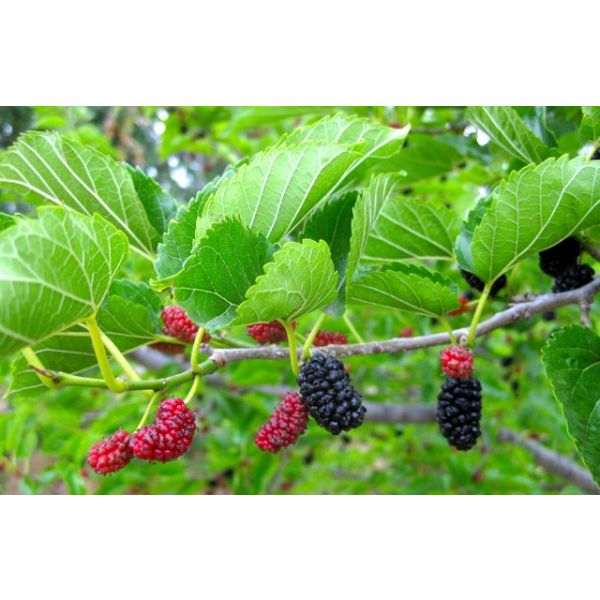Morus Rubra Seeds (Red Mulberry Seeds)
Morus Rubra Seeds (Red Mulberry Seeds)
The tree's value is derived from its abundant fruits, which are eaten by people, birds, and small mammals and is an excellent ornamental tree.

Delivery
All orders shipped with UPS Express.
Always free shipping for orders over US $250.
All orders are shipped with a UPS tracking number.
Returns
Items returned within 14 days of their original shipment date in same as new condition will be eligible for a full refund or store credit.
Refunds will be charged back to the original form of payment used for purchase.
Customer is responsible for shipping charges when making returns and shipping/handling fees of original purchase is non-refundable.
All sale items are final purchases.
Help
Give us a shout if you have any other questions and/or concerns.
Email: [email protected]
Phone: +1 (23) 456 789
Availability: Out of stock
SKU
Morus Rubra
Morus Rubra is better known as Red mulberry and belongs to the Moraceae -Mulberry family. Red mulberry, called moral in Spanish, is widespread in Eastern United States. This species attains its largest size in the Ohio River Valley and reaches its highest elevation (600 m or 2,000 ft) in the southern Appalachian foothills. The tree's value is derived from its abundant fruits, which are eaten by people, birds, and small mammals and is an excellent ornamental tree.
Red mulberry is the only mulberry that you will commonly find in the wild in some area. The red mulberry is a small tree, rarely 50 feet high and 2 feet in diameter, often found growing in the shade of larger trees. This tree is quite urban-tolerant. Mulberries are deciduous trees with scaly buds and terminal buds are absent. The trunk is short and the crown round-topped and dense. The bark is thin, dark grayish brown, peeling off in long, narrow flakes. The buds are imbricate and 1/8-1/4 inch (3-6 mm) long, and the stems exude milky sap when it is cut.
The Morus Rubra leaves are alternate, rounded or somewhat heart-shaped. They are usually undivided with coarsely toothed margins. The foliage is 3 - 5 in (71/2 ? 13 cm) long, hairy and soft on both sides. The leaves of the Red Mulberry are the best way to recognize this species. As the main veins approach the margin of the leaf, they loop around until they are parallel to the margin. Red mulberry is also one of the few trees with leaves that can be mitten-shaped with a single lobe "thumb" on one side, but this is not a good way to identify this tree, because some of them have few or no mitten-shape leaves. Milky juice can be squeezed from the stem of a fresh mulberry leaf.
Red mulberry is dioecious but can be monoecious, with male and female flowers on different branches of the same plants. Both male and female flowers are stalked axillary pendulous catkins and appear in April and May. The female catkins are shorter and appear with the leaves. The flowers are small and greenish.
Each fruit is composed of many small drupelets which develop from separate female flowers ripening together in July and August. The fruits are a single-seeded achene, aggregated into a fleshy fruit that resembles a blackberry. They will change from red to black as they ripen. The fruit is sweet and edible and greatly relished by humans, birds and various animals, and they can be substituted for blackberries in recipes.
The Morus Rubra wood is rather light, soft, not strong, light orange-yellow and very durable in contact with the soil. It is chiefly used for fence posts and fuel.
Hardiness zones :
5 ? 9 (-26c/-15f,-5c/25f) Red mulberry grows under a variety of conditions. It is a rapid-growing tree of valleys, flood plains, and low moist hillsides. Red mulberry grows on a variety of moist soils at elevations below 600 m (2,000 ft). Seeds are carried great distances by birds so trees may be found on any soil that is not too dry. Best development is on well-drained, moist soils of sheltered coves along streams. Red mulberry has been rated as moderately tolerant of flooding as it usually withstands being inundated with up to a foot of water for a single growing season. It normally succumbs, however, after being flooded for two growing seasons. Found on rich, moist soil in mixture with other hardwoods.
Minimum seed-bearing age is usually about 10 years, but 1-year-old trees planted in an abandoned field in east Texas produced fruits at age 4. Optimum seed bearing age is 30 to 85 years; the maximum is 125 years. Good seed crops occur every 2 to 3 years.
| Label | Morus rubra |
|---|---|
| Common name | Red Mulberry |
| Genus | Morus |
| Species | Morus rubra |
| Germination | Soak the Morus Rubra seeds in water for 4 days. Then cold stratify them for 90 days at 1ø to 5ø C (33ø to 41ø F) in moist sand. Then, sow the seeds on the surface of a moist germination medium that you will keep moist but not wet. Germination is epigeal and should occur in about 14 days. Once they do, transplant the seedlings in a good, well-drained potting soil. One-year bare-rooted seedlings may be planted outside. The seed can also be sown in fall without stratification. Germination can take longer. Be patient! |
| Scarification / Stratification | Trempez les graines de Morus Rubra dans l'eau pendant 4 jours. Ensuite, stratifiez-les … froid pendant 90 jours … 1ø … 5ø C (33ø … 41ø F) dans du sable moite. |
| Price View | Price Range |

